In this got-to-have-it-now, got-to-have-it-cheap hobby culture, ground cover isn’t on anyone’s list for accurate modeling. If any thought is given at all, it’s probably along the lines of sprinkle something green around and call it done. It’s just scenery, so who cares…Oh cool! here comes the Limited!!
I’m no longer willing to settle for generic, wannabe scenery. In the smaller scales, maybe you can get away with this but in the larger modeling scales like 1:64 and 1:48, ground cover that looks like the surface of a billiard table isn’t going to cut it. I don’t care if the color is right, without the proper texture and scale, the end result won’t be convincing.
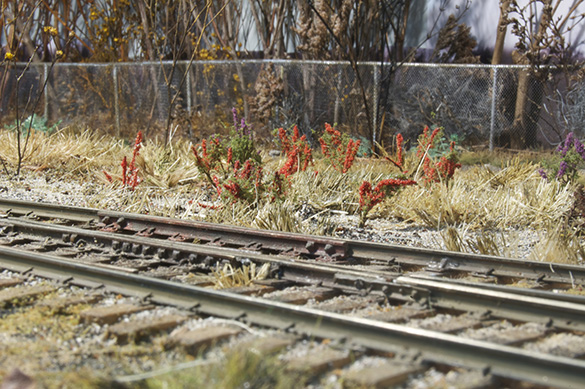
Without the proper texture, ground cover in the larger modeling scales will not fool anyone. You can judge the size and height of the weeds by comparing them to the track. Though they are often missing, we need these frames of reference in our scenery. I need to do something about those garish colors.
The greatest shortcoming is usually a lack of vertical elements. I’m not referring to just trees. That’s a subject all to itself. No, I’m referring here to grasses and weeds and other basic ground covers.
I’ve written about using sisal twine for taller grasses before. I realize many consider my technique of snipping off bits of twine with side cutters and manually inserting them into full strength white glue too laborious, even crazy. Why not use a static applicator or something fast? At this late stage I can’t see spending that kind of money for a single purpose tool that will see limited use. Further, I live in a modeling dead zone with few others to share the cost with. Even if there were others willing to do so, I doubt I would take them up on it. That’s just me. I prefer to forge my own path and do things my way. I don’t do marathon sessions of planting grass this way but tackle it in small chunks. A half an hour here and fifteen minutes there adds up over time and the empty ground gets covered with reasonable progress.
For the longest time, I was satisfied with the sisal grass. It has its limits though. In studying the landscape more closely, I’ve noticed there are distinct layers of vegetation ranging from the smallest moss and grasses all the way up to bigger shrubs and the largest trees. Seldom do we model these layers faithfully.
Recent work near the mill has provided the opportunity to expand my tool box of scenery techniques and materials and I’ve grown especially fond of these bits from JTT.
Consisting of pieces of fine florist wire twisted into crude armatures and covered with gaudy looking ground foam, they aren’t too convincing as trees in any scale. I tested their effect out of the box as seen in the second photo and, given an appropriate season of the year, they’re passable. The purple ones could pass for common thistles but they would not be in bloom in the season I’m modeling. To my eyes, the colors are too garish and not right for my chosen late fall/early winter season. As seen below, that’s easily fixed with a can of spray paint.
Looking better as frost killed weeds, it’s a simple matter of applying them to the landscape, keeping a random spacing and natural growth patterns in mind. In areas of the fiber board roadbed, I use a hammer and small nail to make a hole and stick the pieces in with a spot of carpenters glue. The florist wire is flexible, so if something gets bumped or bent, it’s easy to straighten it back again.
Another key thing to remember is to plant densely. An isolated scraggly weed here or there simply won’t do. Weeds like these grow in dense clusters if conditions are right. These bits come 48 to a package for ten bucks, so, yes, it will add up. Spread the purchases out over time and it becomes manageable like everything else hobby related.
I feel I could take my scenery much farther. The longer I study the real world outside, the more faithfully I want to represent it in miniature. I’m just a rank amateur though and being a Thursday’s child, have a long way to go.
Regards,
Mike
Related posts:
Scenery Progress
Weeding The Yard
Landscape Lessons
Landscape Lessons Applied
A Matter of Perspective
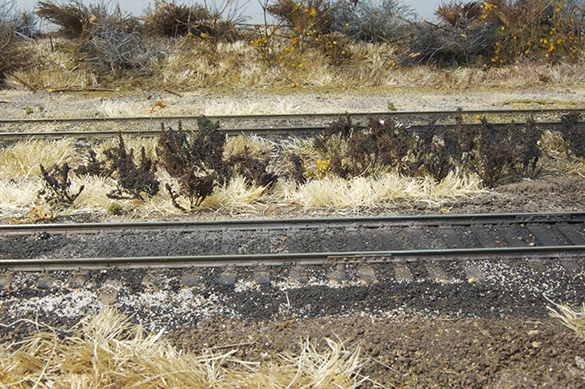
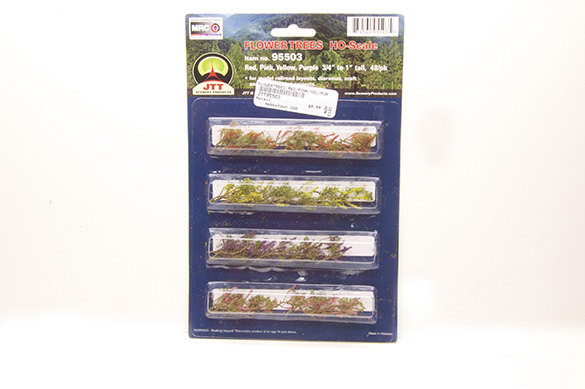
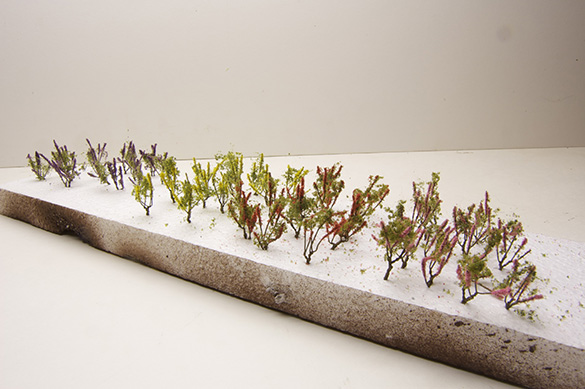
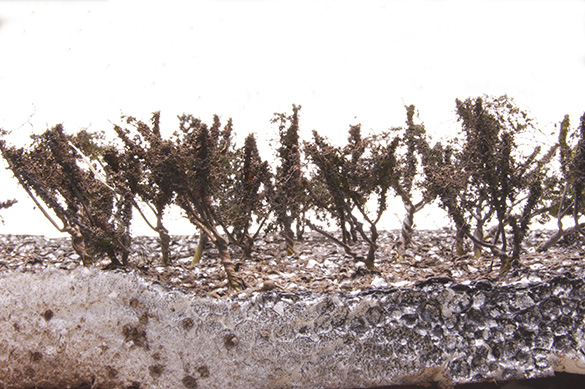
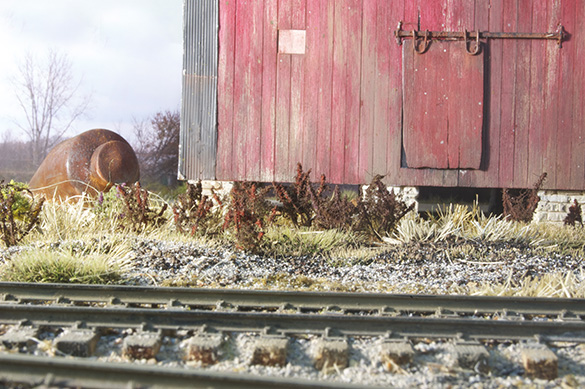
Hi Mike,
Very nice – good point about the clumping. Since they are made from florist’s wire and ground foam, would it not be cheaper to make them yourself?
Not sure what is available in the USA, but here in the UK I recently purchased a crude but effective static grass applicator, which seems to be little more than an electronic fly swatter fitted with a sieve and a ground lead, for less than the equivalent of $20. A quick web search should reveal sources for this, and lots of instructions on how to make one.
Simon
Hi Mike:
I’ve had great success with JTT products. And your readers should know that JTT offers a 20% discount on orders of $1,000 or more. I know – that sounds like a LOT of scenery material. But start adding up what a typical layout costs (scenery, DCC, rolling stock, locomotives, structures, benchwork, trackwork, etc.) and it’s not that much after all.
Cheers!
– Trevor
Hi Simon,
Possibly. It depends on how you calculate the cost, what factors are included etc. As usual though, you have me thinking. The static grass applicator is essentially a no-go at this stage. I have much of the intended grass applied and there are safety issues to consider with those things. I’m an artist, not a mechanical engineer.
Regards,
Mike
Well hello stranger!
I like the JTT products. They add another layer of form and texture to the scene. Don’t see any thousand dollar orders for product in my future though. Good to hear from you Trevor.
Regards,
Mike
I try.
In fact, I can be very trying!
Since you are progressing well, fair enough. As for safety, yes, but common sense and care should suffice: there is no more threat to life than in using an airbrush in an unventilated environment, for example.
Must remember to sign off posts.
Simon